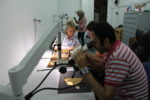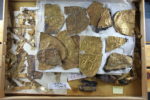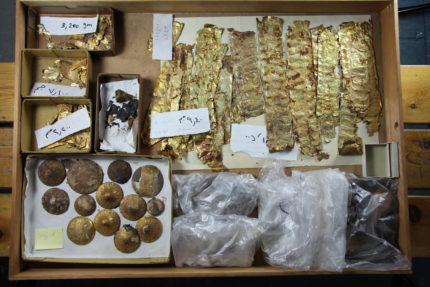 When Howard Carter discovered the tomb of Pharaoh Tutankhamun in 1922, there was such an immense wealth piled inside the small space that his team focused on the large ticket item and packed the rest up. Even finely embossed gold artifacts weren’t important enough to get attention compared to Tutankhamun’s death mask, especially since they were found in pieces before being stashed in the wooden box. They photographed the contents but that was it; they were left uncleaned, unexamined and otherwise undocumented. One of those wooden boxes has been in the stores of the Egyptian Museum Cairo ever since, still uncleaned and unexamined, for decades until 2013 when a collaboration between the Egyptian Museum and Tübingen University archaeologists set out to remedy this 90-year-old oversight. Four years later, the long-awaited goal has been achieved.
When Howard Carter discovered the tomb of Pharaoh Tutankhamun in 1922, there was such an immense wealth piled inside the small space that his team focused on the large ticket item and packed the rest up. Even finely embossed gold artifacts weren’t important enough to get attention compared to Tutankhamun’s death mask, especially since they were found in pieces before being stashed in the wooden box. They photographed the contents but that was it; they were left uncleaned, unexamined and otherwise undocumented. One of those wooden boxes has been in the stores of the Egyptian Museum Cairo ever since, still uncleaned and unexamined, for decades until 2013 when a collaboration between the Egyptian Museum and Tübingen University archaeologists set out to remedy this 90-year-old oversight. Four years later, the long-awaited goal has been achieved.
 The team found the objects in Carter’s original wood crate and began to document and research each piece. They were restored and drawings made of their shape and decorations. The work was painstakingly detailed (hence the four years). In addition to the restoration, documentation and research, the team also faced jigsawing together of the gold fragments. Conservators Christian Eckmann and Katja Broschat were able to place many of the fragments together, ultimately producing about 100 complete or close to complete gold applications that they think were once fittings mounted on bows cases, quivers and horse bridles. One recomposed in their original configurations, the applications could be studied from an art historical perspective. Images embossed on the gold were studied in detail by team member Julia Bertsch, doctoral candidate in archaeology at Tübingen, who was able to identify Egyptian motifs from Middle Eastern ones.
The team found the objects in Carter’s original wood crate and began to document and research each piece. They were restored and drawings made of their shape and decorations. The work was painstakingly detailed (hence the four years). In addition to the restoration, documentation and research, the team also faced jigsawing together of the gold fragments. Conservators Christian Eckmann and Katja Broschat were able to place many of the fragments together, ultimately producing about 100 complete or close to complete gold applications that they think were once fittings mounted on bows cases, quivers and horse bridles. One recomposed in their original configurations, the applications could be studied from an art historical perspective. Images embossed on the gold were studied in detail by team member Julia Bertsch, doctoral candidate in archaeology at Tübingen, who was able to identify Egyptian motifs from Middle Eastern ones.
Among these are images of fighting animals and goats at the tree of life that are foreign to Egyptian art and must have come to Egypt from the Levant. “Presumably these motifs, which were once developed in Mesopotamia, made their way to the Mediterranean region and Egypt via Syria,” explains Peter Pfälzner. “This again shows the great role that ancient Syria played in the dissemination of culture during the Bronze Age.”
Interestingly, he adds, similar embossed gold applications with thematically comparable images were found in a tomb in the Syrian Royal city of Qatna. There, the team of archaeologists from Tübingen led by Pfälzner, discovered a pristine king’s grave in 2002. It dates back to the time of around 1340 B.C., so it is just a bit older than Tutankhamun’s tomb in Egypt. The archaeologist says, “This remarkable aspect provided the impetus for our project on the Egyptian finds.” Now,” says Pfälzner, “we need to solve the riddle of how the foreign motifs on the embossed gold applications came to be adopted in Egypt.” The professor says that here, chemical analyses have been illuminating. “The results showed that the embossed gold applications with Egyptian motifs and the others with foreign motifs were made of gold of differing compositions,” he says. “That does not necessarily mean the pieces were imported. It may be that various local workshops were responsible for producing objects in various styles — and that one used Near Eastern models.”
On Wednesday the gold embossed fittings went on public display for the first time in almost a century in an exhibition at the Egyptian Museum. When this temporary show closes, the artifacts will find a permanent home at the new Grand Egyptian Museum near the pyramids of Giza.

As a kid, I saw some of the major finds on their organized ‘world tour’. If I am correctly informed, Tut was buried in a hurry, the left chamber was messed, and one of the many theories, why he died so young, was some sort of chariot crash.
Those gold plates, as different in style they seem to be, have shapes in common. Therefore, my guess would be indeed that here different craftsmen, i.e. from Egypt and elsewhere, worked together on a project, or some locals simply copied new cool exotic styles from abroad.
There were altogether two or three disassembled chariots, if I remember correctly. That gold foil might have coated one of those, or we are simply dealing here with some sort of broken furniture. A pity that Howard Carter’s shoe box probably wont give further evidence :blankstare: :alien:
How did they piece the gold fragments together and hold them together to form one piece